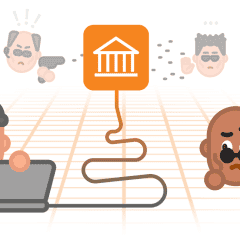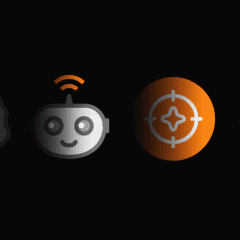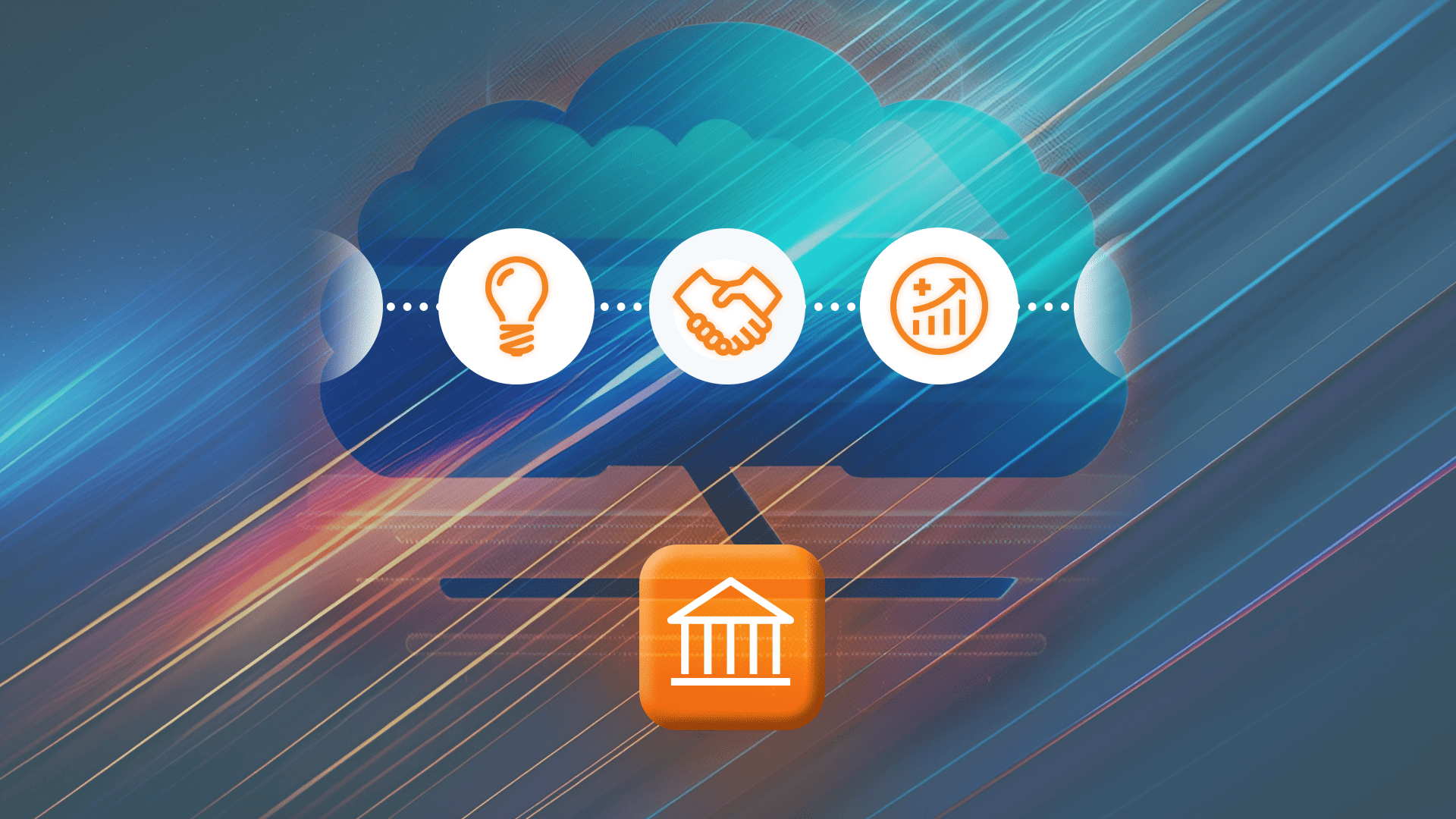If the boom in cloud call center platforms is proof of anything, it is what Winston Churchill, Mahatma Gandhi, or Muhammad Ali (or was it really Tony La Russa?) once said: “In the big leagues, everyone has an ability. It always comes down to mind games. Whoever is more mentally strong — wins.”
Well, it’s the same in the major telecom leagues. Sure, PortaOne has typically targeted “tier 2” telcos, but that number only refers to market size, not ability or ambition. (That modesty has already kept us in the market for over 20 years.) Tier 2 has the ability, and the mental strength. That’s why it’s easy for us to help our partners become winners.
Meet the New Cloud-Based Call Center Platform on the Block
We’ve been looking at mini cloud call center functionality for quite some time. We knew we couldn’t just dive in — we had to focus. In business (and in war), you can’t be “all over the place” simultaneously. That leads to failure (or worse).
VoiP call center software for small business is particularly critical to success, so we had to take particular care. Today, we’re happy to announce that PortaSwitch has officially entered the market as a way for CSPs to offer call center solutions for small business. Did you notice that “officially”? The truth is that many PortaSwitch customers have already been using our software to build their contact center CRM functionality, with or without our official announcements 😂. But now we’re putting it in writing: from this day on, we officially embrace the VoIP cloud contact center solution, and make it our own. That means a more straightforward customer journey and a product vision with the mini cloud call center at its heart.
Trending Is Friending
For us, a cloud call center platform is more than just a new marketing difficulty level. It’s also a 1B+ SERP keyword! That’s super duper massive. The maximum keyword density our blog ever had to face before this was around 100M. Even after we make the necessary SEO tweaks (tweaks we will not disclose here so as not to spoil our PageRank 😉), we are still in the “over 100M” zone. But despite that stiff search engine competition, we still got a “go” for this story. “Some topics are just so good, they should have a story” (quote © our CEO).
Cloud Call Center Honesty, Part 2
From a content marketing standpoint, the green light on a 100M+ keyword means we can toss out all the “best practices” and AI robot assistants 🤖 for getting a decent PageRank and just write whatever we want 😈. (You may think we write these posts only to create jokes nobody understands, but some business KPIs are involved as well.) So, consider this mini cloud call center story our “honesty series, Part 2.”
BTW, just as I’m writing these lines, putin is landing his shells on a power plant, a gas station, and an open market in Kurakhove in the Donetsk oblast. That’s roughly 600 meters from where I am. 😉
Mini Cloud Call Center Software: The (Surprising) Origins
Cloud call center solutions have three decades of history and we would have loved to cover it all. But that history has already been written. And yes, Google, that sentence contains a “followed” link, because content creators (not only PageRank) do deserve proper credit for their work.
Here’s a quick summary for those who can’t or won’t read to the end: the “creation myth” for the mini cloud call center is that a US company called Rockwell Galaxy created the first “Automatic Call Distributor,” or ACD, for Continental Airlines in 1973 to enable faster booking. But while Rockwell was a pioneer and a successful marketer of ACD technology, they weren’t the first. For example, The Birmingham Press and Mail in the UK created a “call center” using British-built GEC PABX 4 in 1965.
ACD appeared on top of another technology called “Private Automatic Branch Exchange,” or PABX. To understand that, though, we first have to understand PBX. What’s the difference? If the missing “A” hasn’t tipped you off yet, here’s the answer: PBX systems were manual or mechanical, not automatic.
And that brings us to the next exciting chapter.
A VoIP Contact Center Prequel: The Private Switchboard PBX and PABX
It all started with greedy lawyers, conspiratologists, and funeral directors. After Alexander Bell’s first successful phone call in 1876, the lawyers did not take too long to take advantage of his invention.
Phone calls were billed per call back then. (And sometimes are even now.) Even if you were calling a colleague in the next room, that still counted as a phone call. Eventually, someone realized that installing an intermediary device between your network and the public network everybody else uses would cut your costs. That’s precisely what a law firm from Richmond, Virginia, did in 1882. They called it a “private switchboard.” What it really turned out to be was a kind of mini call cloud center ur-ancestor.
Mr. Strowger Invents a New Communication Tool for His Funeral Home
The next part of this story moves forward to the grandpa of the modern mini cloud call center. Private switchboards require human operators. In 1891, a funeral director from Kansas City named Almon Strowger invented electro-mechanical switching. One creation myth says that Strowger had suspected that a local switchboard operator was dating his competitor. So, instead of improving his business and customer service, Mr. Strowgler invented the ingenious mechanical machine for automated call routing and took that switchboard operator out of the equation.
In the 1910s, various police and emergency departments all across the world started using PABX for routing incoming calls. The US and Britain were among these pioneers. To serve their network of police boxes, these governments adopted mechanically automated PBX.
TDM, DASS II, DPNSS, SDN, and Other Scary Mini Cloud Call Center Acronyms
Back to ACDs — they started spreading into many sectors throughout the rest of the century: travel, hospitality, healthcare, and more. Time Division Multiplexing (TDM) and the invention of semiconductor chips in 1959 enabled a new digital PBX era. TDM is a technology for sending numerous simultaneous independent calls via a single path. Notably, TDM itself first appeared a century before integrated circuits. Émile Baudot developed TDM and used it for the Hughes Telegraph System in the 1870s.
In the early 1980s, telecom engineers started experimenting with various digital interfaces to enable ACDs and PBX. (By that time, all PBX had become “automatic.” Hence, the acronym dropped the “A.”)
Among the first such interfaces was DASS II (Digital Access Signaling System) — which connected ACDs to the Public Switched Telephone Network (PSTN). To connect operators inside the ACD, engineers used DPNSS (Digital Private Network Signaling System). DPNSS then revolutionized into ISDN, then SDN. Okay, that’s enough scary acronyms. For now.
The Business Side of the Newly Digitized Switching
Cloud call center uptake naturally follows the same path as most evolving solutions do. Wherever you have a new enabling technology, the business will always follow. Around the time DASS, ISDN, and other acronyms started to pop up, various tech entrepreneurs decided to experiment with the “phone calling first” business model.
The banking industry was among the first to realize the competitive advantage of 24/7 availability and remote business. Interestingly, banks in the United Kingdom (a.k.a, the world’s most conservative institutions) were among the first of that first in terms of seizing the opportunity of business contact center technology. The pioneers of teleservices in UK banking were Girobank (now part of Alliance & Leicester), TSB (now Lloyds TSB), and First Direct (now part of HSBC). Then, the US FNB (the First National Bank) joined the ranks of the early telephone banking pioneers.
Welcome, IP PBX and the Outsourced Contact Center
In 1996, Mark Handley, Henning Schulzrinne, Eve Schooler, and Jonathan Rosenberg invented Session Initiation Protocol (SIP), a technology solution that brought about IP PBX (remember that funeral home dude from Kansas City?), digitalized long-distance calling, and enabled remote, cloud, and (ultimately) mini cloud call centers. Spoiler: SIP is dead here in the 2020s. WebRTC is the new king of the block (for systems used on a call center agent’s workspace).
However, in the early 2000s, a new world of technology integration arose with the VoIP call center (and IP PBX technology), resulting in a de facto standard customer support channel. If you were a big, consumer-centered business and did not have a 1-800 (or other, country-specific) customer support number — well, you better should.
The demand for call center services thus brought in a demand for call center agents. At some point, the telecom entrepreneurs realized something: with IP PBX, you could hire those agents anywhere. So that brought in the age of India. That country became the go-to destination for outsourced call centers for two obvious reasons: (1) it’s a country where millions of people are fluent in English (the most required customer support language by far); and (2) the cost of living in India compares competitively to Ukraine, as opposed to New York, London, or Kansas City.
How Is the Mini Cloud Call Center Different?
But small business call center software was still not there yet. Up until the mid-2010s, 1-800 numbers and dedicated customer support centers were the privilege of big or mid-sized businesses. (Even in India and other “tight budget” outsourcing locations.) Building a brick-and-mortar call center and providing its services required significant investment. You had to install “dedicated black boxes,” each at a million-dollar cost and each requiring a million-dollar infrastructure.
For truly big businesses, who serve thousands of customer calls daily, the investment in a hosted cloud center platform was worth it. For small business? Those call center solutions were out of reach.
How the “Cloud Feudals” Facilitated the Appearance of the Mini Cloud Call Center
But the little guys needed to field calls, too. Thus, the ensuing rise of shared call center infrastructure, ultimately leading to the concept of a cloud call center as a service.
As it happens, the need to cut costs coincided with the explosive growth of cloud services (AWS, Google Cloud, Microsoft Azure, and the gang). All those vast businesses invited commoditization of call center functionality. To kill good old Cisco, Genesys, and Aspect, the new “cloud feudals” needed someone young, innovative, and aggressive. Hence? Hello, Twilio!
The Trends Behind the Appearance of Mini Cloud Call Centers
The commoditization of call center functionality via the cloud created a new profile of customer: small businesses (or sometimes medium) with a few hundred calls per day. Typically, that level of volume makes it unnecessary to outsource your customer service overseas, as one or two local customer support people can handle it.
The second trend is the omnichannel approach and the increasing use of social media for customer support as parallel to a small business call center. Your SMM specialist (or even a blog content writer) can now also take customer calls, and route the issue to the relevant subject matter experts in engineering, accounting, or the dev team as needed.
There’s a third trend, too. And that’s the increasing use of data analysis technologies in sales and customer support. Mondago, HubSpot, and Salesforce let you see a holistic customer journey. That makes each contact center customer support call a source of insights and an opportunity for a call to action in your daily business operations.
What Do Quiet Quitting and Async Communication Have to Do with Mini Cloud Call Centers?
Call center platforms are aligned with another trend that you wouldn’t think was related. Ultimately, the COVID lockdown, work-from-home, and the resulting quiet quitting wave combined with the economic recession (provoked by the russian war in Ukraine) brought about the new work/life balance paradigm. (Or, as we call it, the new war/life balance paradigm.) People can work more, and for longer hours. However, they are intentionally doing that work with less focus. The line between work and leisure — at least for those “white collar” 👔 (or should we now call them “white pajamas”?) employees — is becoming increasingly blurred.
Mini cloud call centers enable customer support that is relaxed and yet far more professional and incisive. The people who write the code or account the bills can now provide direct customer support again after decades of that support being outsourced to people with relatively limited ideas about what they are talking about. Customer support can even be asynchronous now, something for which gen Z customers are beginning to show a real preference.
The Evolution of Mini Call Center Features within IP PBX Solutions
Regarding technology, there is no significant difference between a private VoIP call and a business call to a contact center. That’s why IP PBX slowly developed toward call center functionality. (You’ll notice that we use the terms “contact” and “call” center interchangeably in this story.) First, it was call queues. Then it was CRM integration. At some point, small and medium businesses realized they didn’t need “Genesys style” cloud call centers. They can just work with the improved IP PBX solution they already have.
What Makes PortaSwitch a Strong Base for a Mini Cloud Call Center?
We’ll give you the answer first and then dig into the details. PortaSwitch is a strong base for a mini cloud call center solution because, like all of our software, it is flexible. Or, to be more precise (since “flexibility” is often abused in marketing communications), it is a strong base because it offers a CSP the ability to design and build their own end solution, by picking a combination of:
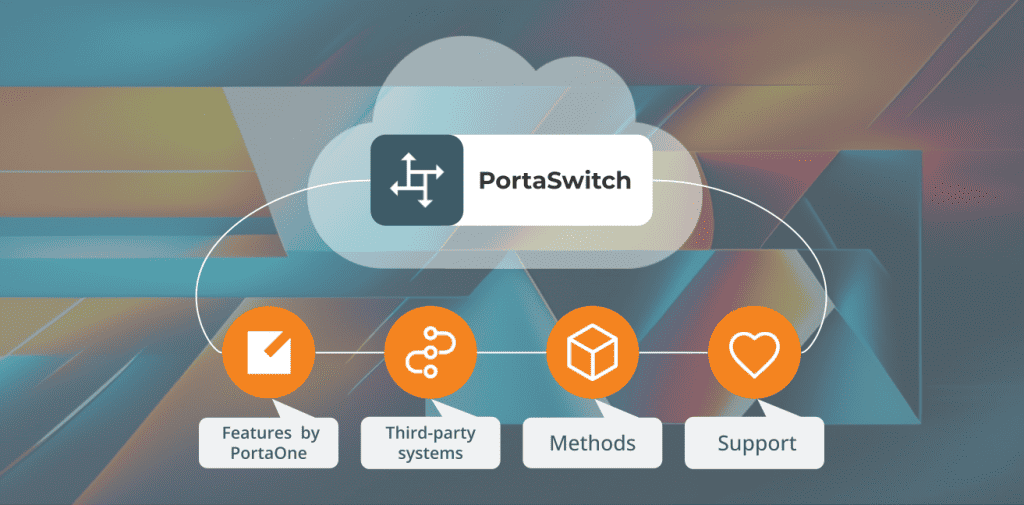
- Features and components provided by PortaOne
- Third-party systems and services (e.g., connecting to ChatGPT to obtain general advice for a customer!)
- Methods (source code modification, API connection, webhooks, Add-On Mart modules, etc.)
- And the engineering teams to execute it (professional services by PortaOne, in-house development, PortaOne technology partners, freelancers, etc.)
This is all combined with the PortaOne “monetization first” approach to designing a solution. Let’s face the truth: the general cloud market and mini-cloud call centers are becoming increasingly commoditized. It’s not about the “killer feature” you offer your end customer anymore. Everybody has activity monitoring, call queues, and wallboards these days. Instead, the differentiators now are about how you charge customers (especially now in the recession-induced “saving mode”) and the flexibility you can offer.
Zero Costs with Zero Margin Still Bring Zero Profit
Recently our CEO and a colleague were discussing an article by Dan Ford for The 360 Blog by Salesforce, and that led to an interesting online conversation. The point our Andriy Zhylenko was making is this: if you digitize a “commodity” service with a near-zero profit margin, sure — you may reduce your losses. However, you still have near-zero profit.
A better strategy for a telco is to look around and use digitalization to build new services that differentiate you and deliver higher value to your customers. An example of such an entrepreneurial approach could be creating a software integration between a CRM system (Salesforce, MondaGo, or others) and a mini cloud call center.
Want an Integrated Mini Cloud Call Center Solution for Your Telco but Finding It a Challenge? We Understand Your Pain
Sorry for making that header far too long. In this story, we promised not to discuss SEO (or even counter-SEO) further. You’ll have to forgive the automatic reflex that your author (a human) has developed after being trained by Yoast (a robot) daily for years. Can’t stop — sorry, Dr. Pavlov. 😂
Back to the issue: PortaOne has been building a SIP-softswitch since 2001, and we run our own contact center (okay, Google: our mini cloud call center) to serve our 500+ customers 24/7 via our support teams in Sumy and Chernihiv.
Inspired by Twilio (you can click, read, and even try it, but you will come back to us), we now update PortaSwitch and our ecosystem projects to be a VoIP solution for “folks outside of the telecom crowd.” However, unlike Twilio (or Microsoft or Cisco), we have no plans to overstep our existing customers in the long run. And even if we went crazy one day and decided we wanted to: we simply can’t.
Why PortaOne Isn’t About Verticals
Cloud call centers are just one piece of a wider picture. See, creating a vertical ecosystem around PortaSwitch (and slowly pushing our existing customers out of it, like those respected competitors we mentioned) would require a caliber of resources that we (a 300+ employees software company from war-torn Ukraine) simply can’t afford. On top of that: we don’t believe in vertical cannibalization. (Or, really, in cannibalization 🎅🏼🦌🥩 of any kind.) There are more straightforward (and brighter) ways of doing business. 👨🏼🌾🦕🌿 So, by investing in your long-term relationship with PortaOne, you are also investing in a business that (by design) has no plans of hurting you.
The Benefits of Having Monetization at the Core
PortaSwitch is a natural evolution stage of PortaBilling, our earlier product from which our PortaOne business originally started. Having billing software at the center of your softswitch means you are equipped with monetization instruments right from your very start. That monetization is very customizable, too, allowing you to make it a joyful experience for your customers (to pay you their money).
“Let’s recall the early times of PortaOne,” offers CEO Andriy. “We had a customer in New Caledonia. They were selling telephony and movie rentals (Netflix was already around at that time, but not the Netflix we know now). Therefore, PortaBilling allowed our customer to bill each rental instance as a billing event.”
Mini Cloud Call Centers and the PortaSwitch License
Are call center solutions for small business a good fit with our licensing model? The short answer: very much yes. Our perpetual, unlimited license gives you enough space for experimentation (unlike most of the competition, with their “pay-per-user” licensing model). For example, we have multiple customers who create CRM integration on top of PortaSwitch-based IP PBX (just like CSPs using other cloud PBX systems do).
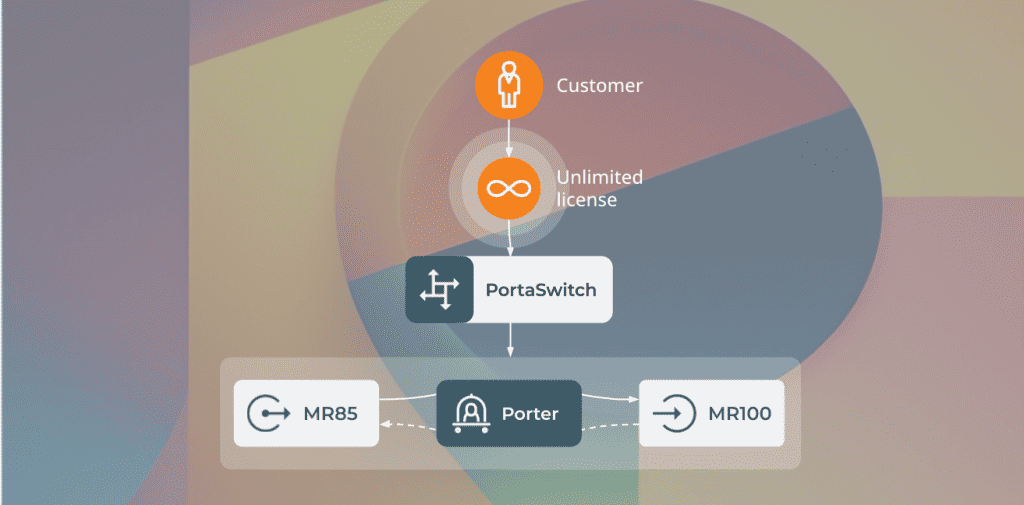
PortaOne customers, though, can step away from typical billing “per user seat.” (This can be a very effective plan since, to a business customer, that “per user seat” sounds like “extra $$$ per month.”) Instead, they can sell the service as “revenue optimization” and bill their customers a revshare “per deal successfully closed” or by “% of increased revenue.” The flexible billing capabilities of PortaSwitch easily allow for this as well.
Additionally, there is no extra cost (from our side) attached to creating these customers with an experimental business model. So you can scale as you like.
The Future of the Mini Cloud Call Center and the PortaSwitch Platform
Let’s wrap this story up. What does the future look like for the mini cloud call center feature enabled by PortaSwitch? To be frank: we will intensively use the market follower (namely: adaptor) strategy here. We neither have the resources at the scale of Genesys nor is the mini cloud call center platform our only business focus. However, even the largest and most successful corporations have successfully used the follower/adaptor strategy. (Hello, Google, Samsung, Microsoft, and Apple.)
Our dear readers (and customers) need to understand how the “adaptor” is fundamentally different from the “counterfeiter” strategy. With counterfeit goods, you usually get a lookalike of dubious quality. With adapted goods, you sometimes get 💎 jewels. Microsoft Teams is in many ways better than Slack, especially in all things VoIP. The author of this text still prefers the latter, though. (Let’s give those first movers their somewhat deserved advantage.)
Cloud Call Center Next Steps: More Interfaces, More AI/ML, More Big Data
Oh, and in 2023 we also plan to implement the PortaSwitch mini cloud call center platform on blockchain for drone deliveries of vodka and humanitarian aid to the Swiss bank account of Anna Vostokova. If you didn’t know — she’s a Ukrainian niece of that Nigerian Prince. (Assuming you have not yet discovered that in your spam folder.) Sorry. Just kiddin’.
Back to (serious) business: currently, we are working on an agent/supervisor interface. This is essential to “going pro” with our mini cloud call center platform. We are also currently in negotiations with several vendors of machine learning solutions for multilingual voice—text—voice conversion. This will enable interesting CRM and call analysis scenarios via PortaSwitch.
We also hope to deliver the AI/ML linguistics functionality “beyond English-only” out of the box. And last (but not least) comes data analysis. “We are happy because recently, we implemented the PortaSIP API as a data source for the mini cloud call center admin panel. Before, we could only rely on PortaBilling information about active sessions,” says Walter White (sorry, Oleg Shevtov), head of the project management department at PortaOne. These API improvements bring new cloud call center data analysis opportunities and various business intelligence tools. Hopefully, in 2023 PortaOne will deliver more APIs for our customers and third-party developers to play with and build their products. When we do, you’ll be the first to hear about it.


